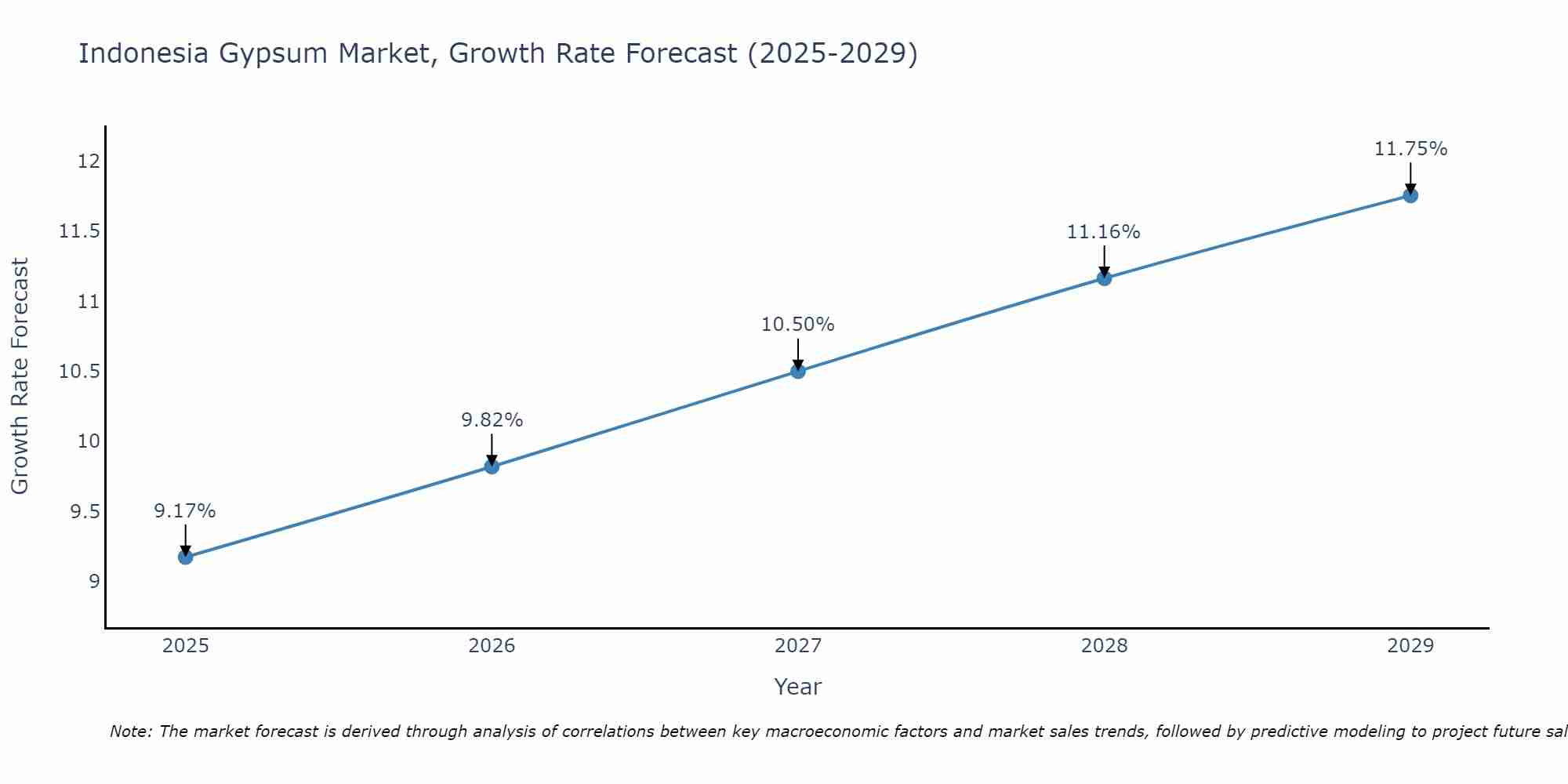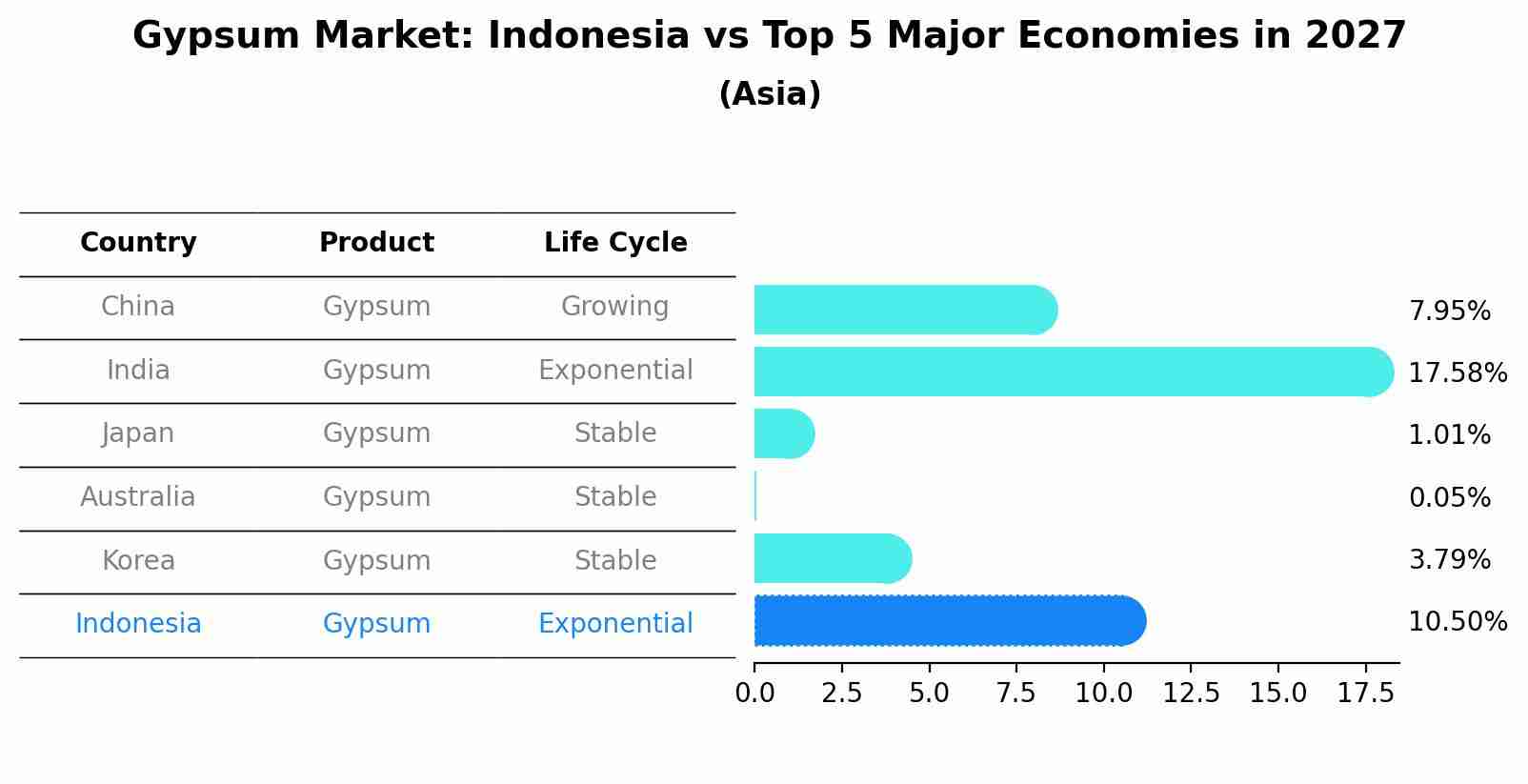Indonesia Gypsum Market (2025-2031) Outlook | Size, Share, Revenue, Industry, Companies, Trends, Value, Growth, Forecast & Analysis
| Product Code: ETC103307 | Publication Date: Jul 2023 | Updated Date: Apr 2025 | Product Type: Report | |
| Publisher: 6Wresearch | No. of Pages: 70 | No. of Figures: 35 | No. of Tables: 5 | |
Indonesia Gypsum Market Size Growth Rate
The Indonesia Gypsum Market is poised for steady growth rate improvements from 2025 to 2029. Commencing at 9.17% in 2025, growth builds up to 11.75% by 2029.

Gypsum Market: Indonesia vs Top 5 Major Economies in 2027 (Asia)
By 2027, Indonesia's Gypsum market is forecasted to achieve a high growth rate of 10.50%, with China leading the Asia region, followed by India, Japan, Australia and South Korea.

Indonesia Gypsum Market Synopsis
The gypsum market in Indonesia refers to the industry involved in the extraction, processing, and distribution of gypsum, a mineral used in various industries such as construction, agriculture, and manufacturing. Gypsum is primarily used in the production of plasterboard, cement, fertilizers, and as a soil amendment.
Market Trends
The construction sector in Indonesia is experiencing significant growth, driven by infrastructure development, commercial and residential construction projects, and urbanization. Gypsum is widely used in construction materials, such as plasterboard and cement, contributing to the growth of the gypsum market. There is a rising demand for sustainable and environmentally friendly building materials. Gypsum-based products, such as plasterboard, are favored due to their recyclability, fire resistance, and sound insulation properties. Gypsum is used as a soil conditioner in agriculture to improve soil structure, drainage, and nutrient availability. With a focus on enhancing agricultural productivity and sustainability, gypsum finds application in farming and horticulture.
Market Drivers
The Indonesia government`s focus on infrastructure development, including transportation systems, energy facilities, and housing projects, drives the demand for gypsum-based materials in construction. Indonesia growing population and urbanization trends lead to increased demand for housing and infrastructure, further fueling the construction industry and, consequently, the gypsum market. Stable economic conditions, increased investment, and rising disposable incomes contribute to the growth of the construction industry and the demand for gypsum products.
COVID-19 Impact on the Market
The COVID-19 pandemic had a notable impact on the gypsum market in Indonesia. Construction activities were temporarily halted or delayed due to lockdowns and restrictions, affecting the demand for gypsum. However, as economic activities resume and construction projects are revived, the market is expected to recover.
Challenges of the Market
Gypsum mining and processing can have environmental impacts, including land degradation and water pollution. Sustainable mining practices and adherence to environmental regulations are essential challenges for the industry. Gypsum faces competition from alternative materials, such as calcium silicate boards and fiber cement boards. Ensuring the cost-effectiveness and advantages of gypsum-based products over substitutes is crucial for market growth.
Industry Key Players
PT Saint-Gobain Construction Products Indonesia, PT Siam-Indo Gypsum Industry, PT Knauf Gypsum Indonesia, PT Citra Gypsum Utama, PT Plafon Perdana Abadi.
Key Highlights of the Report:
- Indonesia Gypsum Market Outlook
- Market Size of Indonesia Gypsum Market, 2024
- Forecast of Indonesia Gypsum Market, 2031
- Historical Data and Forecast of Indonesia Gypsum Revenues & Volume for the Period 2021-2031
- Indonesia Gypsum Market Trend Evolution
- Indonesia Gypsum Market Drivers and Challenges
- Indonesia Gypsum Price Trends
- Indonesia Gypsum Porter's Five Forces
- Indonesia Gypsum Industry Life Cycle
- Historical Data and Forecast of Indonesia Gypsum Market Revenues & Volume By Type for the Period 2021-2031
- Historical Data and Forecast of Indonesia Gypsum Market Revenues & Volume By Impression Plaster for the Period 2021-2031
- Historical Data and Forecast of Indonesia Gypsum Market Revenues & Volume By Model Plaster for the Period 2021-2031
- Historical Data and Forecast of Indonesia Gypsum Market Revenues & Volume By Dental Stone for the Period 2021-2031
- Historical Data and Forecast of Indonesia Gypsum Market Revenues & Volume By Dental Stone High Strength for the Period 2021-2031
- Historical Data and Forecast of Indonesia Gypsum Market Revenues & Volume By Dental Stone High Expansion for the Period 2021-2031
- Historical Data and Forecast of Indonesia Gypsum Market Revenues & Volume By Seting Type for the Period 2021-2031
- Historical Data and Forecast of Indonesia Gypsum Market Revenues & Volume By Hygroscopic Setting Expansion for the Period 2021-2031
- Historical Data and Forecast of Indonesia Gypsum Market Revenues & Volume By Normal Setting Expansion for the Period 2021-2031
- Historical Data and Forecast of Indonesia Gypsum Market Revenues & Volume By Application for the Period 2021-2031
- Historical Data and Forecast of Indonesia Gypsum Market Revenues & Volume By Pre-Engineered Metal Buildings for the Period 2021-2031
- Historical Data and Forecast of Indonesia Gypsum Market Revenues & Volume By Residential for the Period 2021-2031
- Historical Data and Forecast of Indonesia Gypsum Market Revenues & Volume By Industrial for the Period 2021-2031
- Historical Data and Forecast of Indonesia Gypsum Market Revenues & Volume By Commercial for the Period 2021-2031
- Historical Data and Forecast of Indonesia Gypsum Market Revenues & Volume By Institutional for the Period 2021-2031
- Indonesia Gypsum Import Export Trade Statistics
- Market Opportunity Assessment By Type
- Market Opportunity Assessment By Seting Type
- Market Opportunity Assessment By Application
- Indonesia Gypsum Top Companies Market Share
- Indonesia Gypsum Competitive Benchmarking By Technical and Operational Parameters
- Indonesia Gypsum Company Profiles
- Indonesia Gypsum Key Strategic Recommendations
Frequently Asked Questions About the Market Study (FAQs):
1 Executive Summary |
2 Introduction |
2.1 Key Highlights of the Report |
2.2 Report Description |
2.3 Market Scope & Segmentation |
2.4 Research Methodology |
2.5 Assumptions |
3 Indonesia Gypsum Market Overview |
3.1 Indonesia Country Macro Economic Indicators |
3.2 Indonesia Gypsum Market Revenues & Volume, 2021 & 2031F |
3.3 Indonesia Gypsum Market - Industry Life Cycle |
3.4 Indonesia Gypsum Market - Porter's Five Forces |
3.5 Indonesia Gypsum Market Revenues & Volume Share, By Type, 2021 & 2031F |
3.6 Indonesia Gypsum Market Revenues & Volume Share, By Seting Type, 2021 & 2031F |
3.7 Indonesia Gypsum Market Revenues & Volume Share, By Application, 2021 & 2031F |
4 Indonesia Gypsum Market Dynamics |
4.1 Impact Analysis |
4.2 Market Drivers |
4.3 Market Restraints |
5 Indonesia Gypsum Market Trends |
6 Indonesia Gypsum Market, By Types |
6.1 Indonesia Gypsum Market, By Type |
6.1.1 Overview and Analysis |
6.1.2 Indonesia Gypsum Market Revenues & Volume, By Type, 2021-2031F |
6.1.3 Indonesia Gypsum Market Revenues & Volume, By Impression Plaster, 2021-2031F |
6.1.4 Indonesia Gypsum Market Revenues & Volume, By Model Plaster, 2021-2031F |
6.1.5 Indonesia Gypsum Market Revenues & Volume, By Dental Stone, 2021-2031F |
6.1.6 Indonesia Gypsum Market Revenues & Volume, By Dental Stone High Strength, 2021-2031F |
6.1.7 Indonesia Gypsum Market Revenues & Volume, By Dental Stone High Expansion, 2021-2031F |
6.2 Indonesia Gypsum Market, By Seting Type |
6.2.1 Overview and Analysis |
6.2.2 Indonesia Gypsum Market Revenues & Volume, By Hygroscopic Setting Expansion, 2021-2031F |
6.2.3 Indonesia Gypsum Market Revenues & Volume, By Normal Setting Expansion, 2021-2031F |
6.3 Indonesia Gypsum Market, By Application |
6.3.1 Overview and Analysis |
6.3.2 Indonesia Gypsum Market Revenues & Volume, By Pre-Engineered Metal Buildings, 2021-2031F |
6.3.3 Indonesia Gypsum Market Revenues & Volume, By Residential, 2021-2031F |
6.3.4 Indonesia Gypsum Market Revenues & Volume, By Industrial, 2021-2031F |
6.3.5 Indonesia Gypsum Market Revenues & Volume, By Commercial, 2021-2031F |
6.3.6 Indonesia Gypsum Market Revenues & Volume, By Institutional, 2021-2031F |
7 Indonesia Gypsum Market Import-Export Trade Statistics |
7.1 Indonesia Gypsum Market Export to Major Countries |
7.2 Indonesia Gypsum Market Imports from Major Countries |
8 Indonesia Gypsum Market Key Performance Indicators |
9 Indonesia Gypsum Market - Opportunity Assessment |
9.1 Indonesia Gypsum Market Opportunity Assessment, By Type, 2021 & 2031F |
9.2 Indonesia Gypsum Market Opportunity Assessment, By Seting Type, 2021 & 2031F |
9.3 Indonesia Gypsum Market Opportunity Assessment, By Application, 2021 & 2031F |
10 Indonesia Gypsum Market - Competitive Landscape |
10.1 Indonesia Gypsum Market Revenue Share, By Companies, 2024 |
10.2 Indonesia Gypsum Market Competitive Benchmarking, By Operating and Technical Parameters |
11 Company Profiles |
12 Recommendations |
13 Disclaimer |
- Single User License$ 1,995
- Department License$ 2,400
- Site License$ 3,120
- Global License$ 3,795
Search
Related Reports
- Portugal Electronic Document Management Market (2025-2031) | Strategy, Consumer Insights, Analysis, Investment Trends, Opportunities, Growth, Size, Share, Industry, Revenue, Segments, Value, Segmentation, Supply, Forecast, Restraints, Outlook, Competition, Drivers, Trends, Demand, Pricing Analysis, Competitive, Strategic Insights, Companies, Challenges
- France Electronic Document Management Market (2025-2031) | Strategy, Consumer Insights, Analysis, Investment Trends, Opportunities, Growth, Size, Share, Industry, Revenue, Segments, Value, Segmentation, Supply, Forecast, Restraints, Outlook, Competition, Drivers, Trends, Demand, Pricing Analysis, Competitive, Strategic Insights, Companies, Challenges
- Portugal Occupational Health & Safety Services Market (2025-2031) | Strategy, Consumer Insights, Analysis, Investment Trends, Opportunities, Growth, Size, Share, Industry, Revenue, Segments, Value, Segmentation, Supply, Forecast, Restraints, Outlook, Competition, Drivers, Trends, Demand, Pricing Analysis, Competitive, Strategic Insights, Companies, Challenges
- Netherlands Occupational Health and Safety Services Market (2025-2031) | Strategy, Consumer Insights, Analysis, Investment Trends, Opportunities, Growth, Size, Share, Industry, Revenue, Segments, Value, Segmentation, Supply, Forecast, Restraints, Outlook, Competition, Drivers, Trends, Demand, Pricing Analysis, Competitive, Strategic Insights, Companies, Challenges
- Belgium and Luxembourg Facility Management Market (2025-2031) | Strategy, Consumer Insights, Analysis, Investment Trends, Opportunities, Growth, Size, Share, Industry, Revenue, Segments, Value, Segmentation, Supply, Forecast, Restraints, Outlook, Competition, Drivers, Trends, Demand, Pricing Analysis, Competitive, Strategic Insights, Companies, Challenges
- Russia Women Intimate Apparel Market (2025-2031) | Strategy, Consumer Insights, Analysis, Investment Trends, Opportunities, Growth, Size, Share, Industry, Revenue, Segments, Value, Segmentation, Supply, Forecast, Restraints, Outlook, Competition, Drivers, Trends, Demand, Pricing Analysis, Competitive, Strategic Insights, Companies, Challenges
- Africa Chocolate Market (2025-2031) | Size, Share, Trends, Growth, Revenue, Analysis, Forecast, industry & Outlook
- Global Hydroxychloroquine And Chloroquine Market (2025-2031) | Industry, Trends, Size, Outlook, Growth, Value, Companies, Revenue, Analysis, Share, Forecast
- Saudi Arabia Plant Maintenance Market (2025-2031) | Industry, Size, Growth, Revenue, Value, Companies, Forecast, Analysis, Share & Trends
- Taiwan Electric Truck Market (2025-2031) | Outlook, Industry, Revenue, Size, Forecast, Growth, Analysis, Share, Companies, Value & Trends
Industry Events and Analyst Meet
Our Clients
Whitepaper
- Middle East & Africa Commercial Security Market Click here to view more.
- Middle East & Africa Fire Safety Systems & Equipment Market Click here to view more.
- GCC Drone Market Click here to view more.
- Middle East Lighting Fixture Market Click here to view more.
- GCC Physical & Perimeter Security Market Click here to view more.
6WResearch In News
- Doha a strategic location for EV manufacturing hub: IPA Qatar
- Demand for luxury TVs surging in the GCC, says Samsung
- Empowering Growth: The Thriving Journey of Bangladesh’s Cable Industry
- Demand for luxury TVs surging in the GCC, says Samsung
- Video call with a traditional healer? Once unthinkable, it’s now common in South Africa
- Intelligent Buildings To Smooth GCC’s Path To Net Zero













